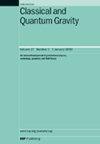用多模共振质量探测器探测中子星并合的千赫重子
IF 3.6
3区 物理与天体物理
Q2 ASTRONOMY & ASTROPHYSICS
引用次数: 0
摘要
我们提出了一个由尺寸递减的质量元素组成的多模棒,通过受激吸收来自双中子星合并和合并后的高达kHz的引力子来实现光电效应的引力版本。我们发现,多模探测器具有与最大质量元素的引力波保持耦合强度的正常模式,而其有效质量仅与最小元素的质量相当。这使得正常模式由于吨级最大质量而具有引力子吸收率,而正常模式下的单个引力子吸收过程原则上可以通过小于皮克尺度的质量元的能量测量来解决。我们论证了通过末端质量的能量测量直接计数棒子中引力声子的可行性。这改善了单引力子信号的转导,提高了探测单引力子的可行性。本文章由计算机程序翻译,如有差异,请以英文原文为准。
Detecting kHz gravitons from a neutron star merger with a multi-mode resonant mass detector
We propose a multi-mode bar consisting of mass elements of decreasing size for the implementation of a gravitational version of the photo-electric effect through the stimulated absorption of up to kHz gravitons from a binary neutron star merger and post-merger. We find that the multi-mode detector has normal modes that retain the coupling strength to the gravitational wave of the largest mass-element, while only having an effective mass comparable to the mass of the smallest element. This allows the normal modes to have graviton absorption rates due to the tonne-scale largest mass, while the single graviton absorption process in the normal mode could be resolved through energy measurements of a mass-element in-principle smaller than pico-gram scale. We argue the feasibility of directly counting gravito-phonons in the bar through energy measurements of the end mass. This improves the transduction of the single-graviton signal, enhancing the feasibility of detecting single gravitons.
求助全文
通过发布文献求助,成功后即可免费获取论文全文。
去求助
来源期刊

Classical and Quantum Gravity
物理-天文与天体物理
CiteScore
7.00
自引率
8.60%
发文量
301
审稿时长
2-4 weeks
期刊介绍:
Classical and Quantum Gravity is an established journal for physicists, mathematicians and cosmologists in the fields of gravitation and the theory of spacetime. The journal is now the acknowledged world leader in classical relativity and all areas of quantum gravity.
 求助内容:
求助内容: 应助结果提醒方式:
应助结果提醒方式:


